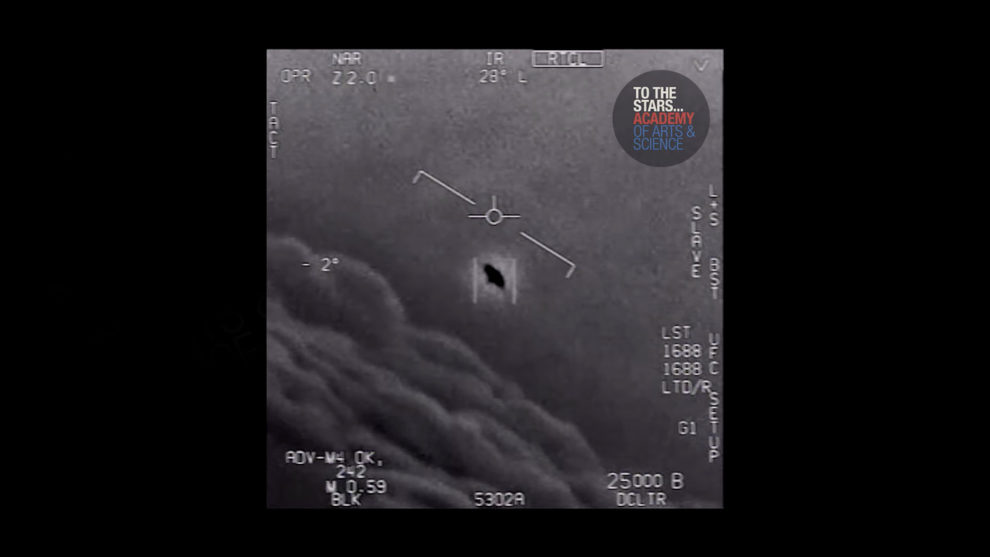
Cue “The X-Files” music and put on your tinfoil hats. We’re going for a ride.
Last month the U.S. Navy confirmed that three videos of unidentified aerial phenomena (UAP) taken by airplane pilots a few years ago are indeed authentic. (Notice we’re not saying “unidentified flying object,” or UFO.) This means the videos went through the U.S. military, so it can be assumed they have not been computer-generated or altered.
Three clips dubbed “FLIR1,” “Gimbal” and “Go Fast” show two encounters between Navy aircraft and UAP. The object was tracked by the aircraft’s Raytheon RTN, +0.33% AN/ASQ-228 Advanced Targeting Forward-Looking Infrared (ATFLIR) Pod, and in all three videos, it performed maneuvers that cannot be executed using current aviation technology.
Commander David Fravor, who flew one of the fighters in the video (“Gimbal”), describes the object as “Tic Tac”-shaped, 40-feet long, with no wings, exhaust or discernible propulsion. After some maneuvering, the object ended up hovering above the water. Moments later, it rapidly ascended to 12,000 feet and finally accelerated away at a speed the commander suggested was “well above supersonic.”
Unsustainable G-forces
When asked if a human pilot could survive such an acceleration in a modern aircraft, Fravor responded with a resounding “no.” Acceleration of that magnitude would wreak havoc on the human body: broken bones, shifting of organs, burst blood vessels and even death would occur as the body was crushed with G-forces it could not withstand.
But let’s consider for a second that the mysterious object in question was manned by a human pilot. In that case, the vehicle would have to be equipped with the technology capable of reducing the inertial mass of the object by generating gravity waves to reduce G-forces during acceleration.
Navy patent
Perhaps this could be achieved if the outer shell of the craft were turned into a cavity wall filled with gas, which would vibrate thanks to microwave emitters. This description was taken from a patent the U.S. Navy applied for in 2016, which says such a peculiar craft could move with great ease through air, space or water by being enclosed in a vacuum plasma bubble or sheath.
That could be the UAP that Fravor saw during his documented flight. Gravity manipulating tech at play could explain how the craft was able to effortlessly perform certain maneuvers such as suddenly turning sideways without losing altitude (aka knife-edge flight) in the FLIR1 video, or rapidly changing in-flight direction without visible inertia.
While the patent for the mysterious craft was approved last year, there is no indication that it was built or tested. Then again, it’s hard to imagine that a military aircraft equipped with this kind of technology would get any publicity.
Accidental release
If it indeed was this craft in the video, it was built and tested prior to the patent application. However, it could be that the cat got out of the bag. That could be why the Navy reluctantly acknowledged the authenticity of the footage, while also outlining that it wasn’t cleared for public release.
So far, the pieces of the puzzle seem to be falling into place. Then again, at about the 1:17 mark in the video above, one pilot says: “There’s a whole fleet of them. Look on the ASA.” ASA is most likely AESA, the APG-79 radar’s “search while track” feature that enables it to follow multiple targets without degradation to its search capability. Having one experimental craft exposed during a mission is a likely event, but what about a whole fleet?
Two explanations
We have two possibilities: First, there was more than one mysterious aircraft at the location, but it’s unlikely any of them was our patented vehicle.
Another explanation could be that because of the vacuum sheath or another type of stealth technology surrounding the UAP, radar erroneously reported multiple bogies, where in fact there was only one.
That would also explain why the pilot had a hard time locking on to the target in “FLIR1” and “Go Fast” videos. The speed must have played a role as well. Clinicians have a saying: Common things are common. If it looks like a duck, swims like a duck and quacks like a duck, then it probably is a duck.
So what do you think is more likely? A Navy experimental aircraft, inadvertently uncovered by pilots, or an alien UFO? My bet is on the latest Navy patent, but I’m open to suggestions. Please share them in the comment section below. You can take your tinfoil hat off now.
Jurica Dujmovic is a MarketWatch columnist.








